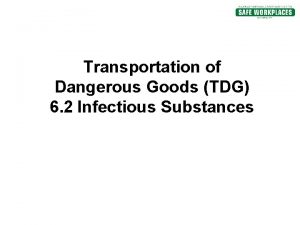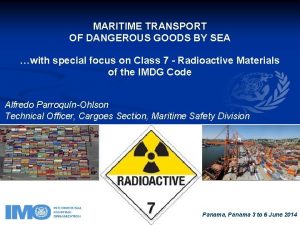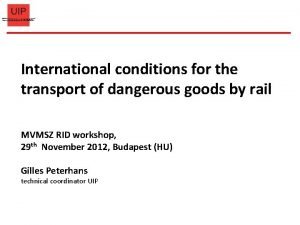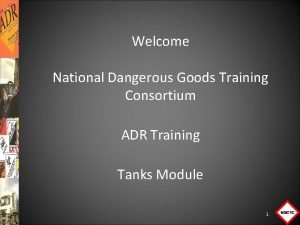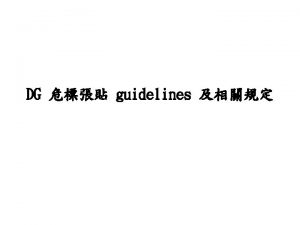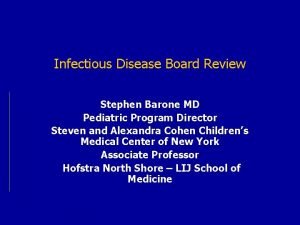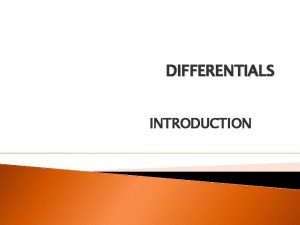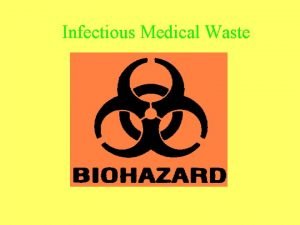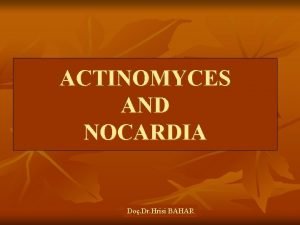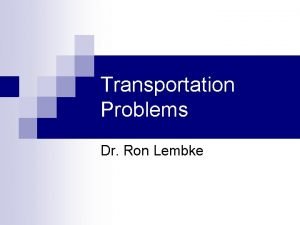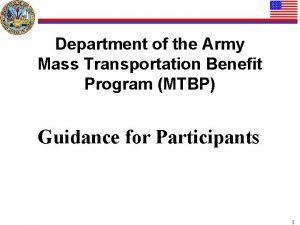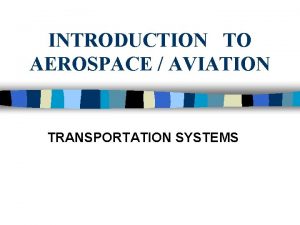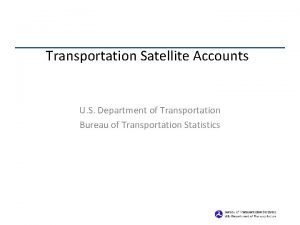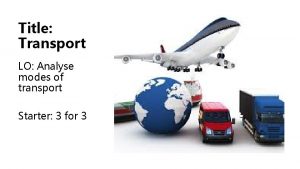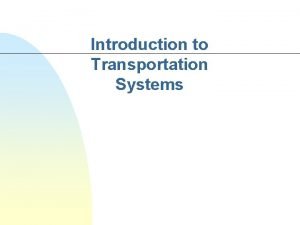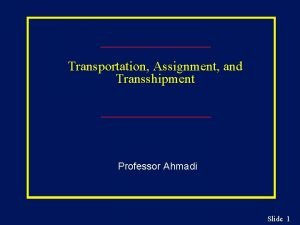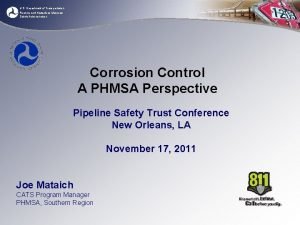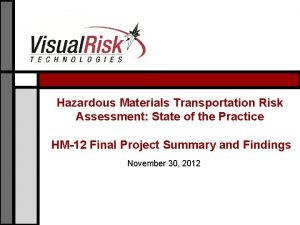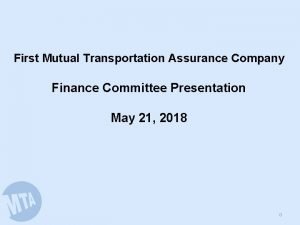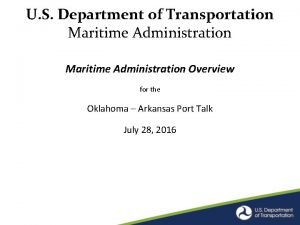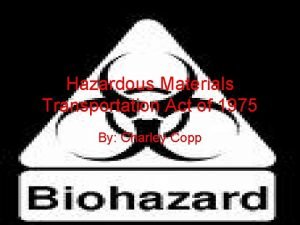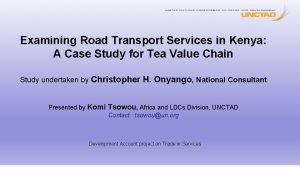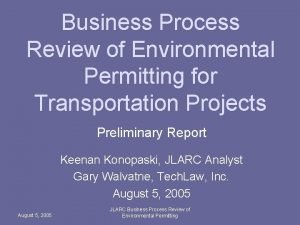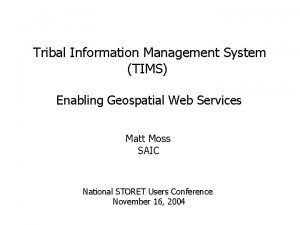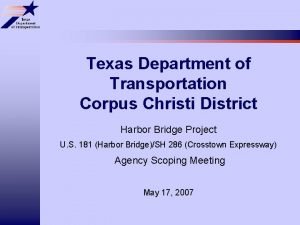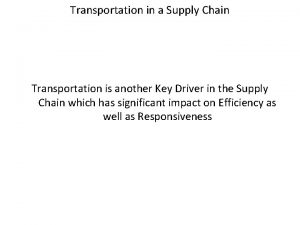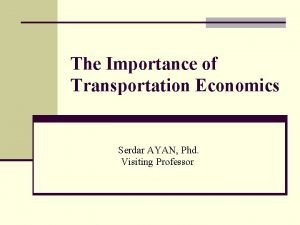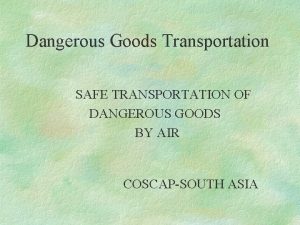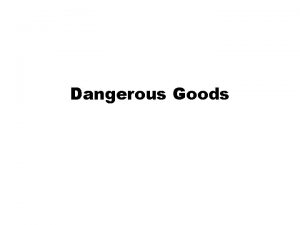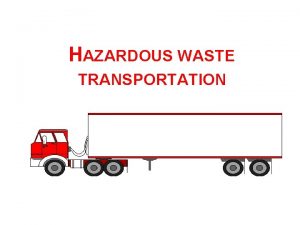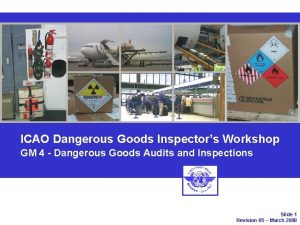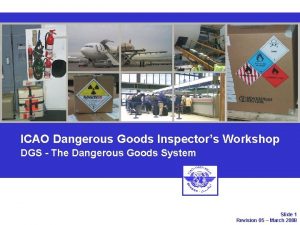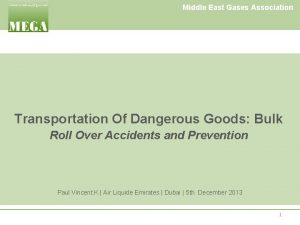Transportation of Dangerous Goods TDG 6 2 Infectious
































































































- Slides: 96

Transportation of Dangerous Goods (TDG) 6. 2 Infectious Substances

Safety First! Housekeeping: § Evacuation route/Muster point § Washrooms § Cell phones Administration: § Sign in sheet § Evaluation

Course Participation This session will be a hands-on learning experience with lots of interactive participation/discussion. Please ask questions, voice comments and concerns as we go.

Course Agenda 1. Introductions and Expectations 2. Legislation 3. Training Considerations 4. Transport Canada’s TDG Ground Regulations 5. Air Regulations: IATA 6. Written Exam and Course Evaluation

Introductions and Expectations Your name What types of materials are shipped To where and by what means Anything else you’d like to share with respect to your expectations of this course

Rights, Responsibilities & Accountability Saskatchewan’s Occupational Health & Safety Regulations, 1996, set out the general requirements of the employer and workers.

TDG Act & Regulations Published by Transport Canada Federal laws that stipulate the roles of the worker and the employer with respect to shipping hazardous substances. Layout instructions for safe and legal transport by road, rail, and ship. Both laws (OH&S and Transport Canada’s) hold the employer accountable for provision of training and a safe work environment; and the worker is accountable for following safe work practices and reporting unsafe conditions.

Shipping by Ground § Legislation § The Importance of Training § Enforcement § Documentation § General Overview § ERAP § The 9 TDG Classes § Reporting § The Regulations Parts § Enforcement § The Regulations Schedules § Summary § Key Terms & Definitions § Roles & Responsibilities in the Transport Chain

TDG Act and Regulations Public Safety: The TDG Act & Regulations are meant to ensure that hazards associated with the movement of dangerous goods are minimized by: § Use of standardized, tested containers § Clear communication of hazards § Documented tracking of hazardous shipments § Provision of effective emergency response plans

Enforcement Federal inspectors enforce the law. They can: § inspect shipments and training documents § issue warnings § write tickets There are monetary penalties, creative sentencing options, and jail time for noncompliance. Where violations occur, everyone in the shipping chain can be charged.

General Overview 1. Personnel must be ‘trained’ and ‘certified’ 2. Substances must be ‘classified’ 3. Containers must be ‘in standard’ 4. Containers must have ‘safety marks’ 5. Documentation must be completed and accompany the shipment 6. Packaging must follow instructions 7. Spills must be reported

The 9 TDG Classes 1. Explosives 2. Gases 3. Flammable Liquids 4. Flammable Substances 5. Oxidizers & Organic Peroxides 6. Toxic & Infectious Substances 7. Radioactive 8. Corrosives 9. Miscellaneous (includes Dry Ice)

Ground Regulations Part Topic The Regulations by Parts 1 General (including definitions) & Exceptions 2 Classification 3 Documentation 4 Safety Marks (labels & placards) 5 Means of Containment (packaging) 6 Training 7 Emergency Response 8 Reporting (spills or imminent spills) 9 -12 Transport 13 -16 Enforcement

Ground Regulations Schedule The Contents by Parts Regulations 1 Listing of substances by UN Number 2 Special Provisions 3 Listing of substances by Shipping Name

Schedule 1 Col 2 Col 3 Col 4 Col 5 Col 6 a Col 6 b Col 7 Col 8 Col 9 UN # Shipping Name and Description Class Packing Group/Category Special Provisions Explosive Limit & Limited Quantity Index UN 2814 INFECTIOUS SUBSTANCE, AFFECTING HUMANS 6. 2 Category A 16, 38, 84, 164 0 EO See SP 84 . 05 kg or . 05 l UN 2900 INFECTIOUS SUBSTANCE, AFFECTING ANIMALS only 6. 2 Category A 16, 38, 84, 164 0 EO See SP 84 . 05 kg or . 05 l UN 3373 BIOLOGICAL SUBSTANCE, CATEGORY B 6. 2 Category B 38, 164, 165 0 EO UN 1845 CARBON DIOXIDE, SOLID; or DRY ICE 9 18 0 EO Passenger carrying Excepted Carrying Ship Road or rail Index index Quantities ERAP Index 4 kg or 4 l 200 kg

Schedule 3 Col 1 a Col 1 b Col 2 Col 3 Col 4 Shipping Name and Description Appellation reglementaire ou technique Primary Class UN Number Marine Pollutant INFECTIOUS SUBSTANCE, AFFECTING HUMANS 6. 2 UN 2814 INFECTIOUS SUBSTANCE, AFFECTING ANIMALS only 6. 2 UN 2900 BIOLOGICAL SUBSTANCE, CATEGORY B 6. 2 UN 3373 CARBON DIOXIDE, SOLID 9 UN 1845

Part 1 - Key Terms & Definitions a. Classification i. Culture b. Shipping Name j. Biological Product c. UN Number k. Neutralized/Inactivated d. Primary Class l. Exposure e. Infectious Substance m. Means of Containment f. Category A n. Safety Marks g. Category B h. Exempt Specimens

Classification for infectious substance includes all of: § UN number § shipping name § primary class § the infectious substance category

Classification - General

Classification – Patient Specimens

Shipping Name The official name of a substance is found in Schedule 1, Column 2. This is the name that must appear on shipping documents. Not necessarily the technical name, especially for biological materials. Example: § Shipping name: Infectious Substance, affecting humans § Technical name: Mycobacterium tuberculosis

Shipping Name and UN Numbers For shipping biological materials, the main shipping names are: § Infectious substance affecting humans UN 2814, Category A § Infectious substance affecting animals UN 2900, Category A § Biological substance, Category B UN 3373 § Exempt Specimen § Clinical Waste, N. O. S. UN 3291 § (BIO) Medical Waste, N. O. S. UN 3291 § Regulated Medical Waste, N. O. S. UN 3291

Primary Class The primary hazard class the substance is assigned to. § For infectious substances, the Class is 6. 2. § For dry ice (a ‘Miscellaneous’ substance), the Class is 9. Infectious Substance A substance known or reasonably believed to contain viable micro -organisms such as bacteria, viruses, rickettsia, parasites, fungi, and other agents such as prions that are known or reasonably believed to cause disease in humans or animals.

Criteria Category A An infectious substance that is being transported in a form such that, when released outside its means of containment and there is physical contact with humans or animals, it is capable of causing permanent disability or life-threatening or fatal disease in humans or animals. Category B Infectious substances that do not meet the criteria for inclusion in Category A.

Exempt Specimens Biological materials, collected directly from humans, animals or the environment that are being transported for research, diagnosis, investigational activities or prevention where you have NO REASON TO BELIEVE that the specimen contains an infectious substance. TDG Regulation 1. 42.

Exempt Specimens Includes excreta, secrete, blood components, tissue swabs, and body parts. 3 Types of Exempt Specimens: 1. Exempt Human Specimen 2. Exempt Animal Specimen 3. Biological Product

Are All Specimens Exempt? NO!!!! If you HAVE REASON TO BELIEVE that the specimen contains Class 6. 2 micro-organisms, the specimens are classified as Class 6. 2 and assigned to either Category A or B. If the specimens are part of routine screening tests, they would be shipped as per section 1. 42 of the TDG Regulations.

Culture The result of a process by which pathogens in a specimen are intentionally propagated. This definition does not include specimens taken from a human or animal and that are intended to be processed in a laboratory. Biological Product A product derived from living organisms that is used to prevent, treat or diagnose disease in humans or animals or in the development, experimentation or investigation of disease. This includes finished or unfinished products, live vaccines and attenuated vaccines.

Neutralized/Inactivated Substances in a form that any pathogens present have been treated such that they no longer pose a health risk. These neutralized/inactivated/fixed materials are not subject to the Regulations unless they meet the criteria for inclusion in another class. For example, fixed samples are not infectious, but the fixative is often flammable.

Exposure An exposure occurs when an infectious substance is released outside of the protective packaging, resulting in physical contact with humans or animals.

Means of Containment The shipping container. Approved containers meet specific standards and have undergone detailed testing (dropping, crushing, piercing) to ensure that they will meet the rigors of shipping without releasing the dangerous goods packed within them. § Small = less than 450 L or 500 kg § Large = more than 450 L or 500 kg

Means of Containment

Means of Containment

Safety Marks - Labelling of the Container The labels and other information that consignors are required to put on the outside of the rigid outer packaging to indicate the presence and type of hazard. Also provides information about the construction and durability of the shipping container. See the Regulations Part 4 or the TDG Bulletin Shipping Infectious Substances for more information.

Safety Marks - Labelling of the Container Shipments must be labeled prior to transport (Regulation 4. 4) Labels must remain legible during transport (Regulation 4. 5) Labels must be removed after hazard is removed from the container (Regulation 4. 9) Labels must be applied ‘on point’ and be 100 mm x 100 mm (Regulation 4. 7)

Safety Marks - Labelling of the Container The container labelling requirements vary with the classification of the shipment but always includes the shipping name, UN Number, container specification marks and address of the consignor.

Safety Marks - Labels Category A If you are shipping a Cat. A, you must label the pack with an infectious substance label. This label is illustrated in the Appendix to Part 4 of the TDG Regulations. Category B Exempt Specimen When shipping a Category B No label required. infectious substance, section 1. 39 and 4. 22. 1 say you must label the package with the “Category B mark” illustrated in the appendix to Part 4. The text on the (bilingual) label is: The text on the label is: INFECTIOUS UN 3373 IN CASE OF DAMAGE OR LEAKAGE 24 - Hour Telephone Number IMMEDIATELY NOTIFY LOCAL AUTHORITIES AND CANUTEC 613 -996 -6666 Extra marking requirements: The shipping name and UN number The shipping name • Exempt Human Specimen • UN 2814 – Infectious Substance, • Shipping name is required • Exempt Animal Specimen Affecting Humans, or if you are using the • UN 2900 – Infectious Substance, exemption under section Affecting Animals 1. 39

Safety Marks - Placards The placard that carriers or anyone loading the dangerous goods into a means of transport are required to display on the vehicle. Placards are required when the: § gross mass of infectious substances >500 kg § shipment requires an ERAP (see Transport Canada’s Regulations, Subsection 7. 1(7)) See the Regulations Part 4 or the TDG Bulletin Shipping Infectious Substances for more information.

Roles & Responsibilities in the Transport Chain The TDG Regulations define the roles and responsibilities of everyone in the transport chain: § Employer/Supervisor § Consignor § Carrier § Consignee

Roles & Responsibilities - Employer The TDG Regulations Part 6. 1 Training Certificate Requirements The TDG Regulations Part 6. 3 Issuance & Contents of a Training Certificate The TDG Regulations Part 6. 5 Keeping Proof of Training The TDG Regulations Part 6. 7 Showing Proof of Training

Consignor (Shipper) A person who: § is named in a shipping document § will import dangerous goods § has possession of dangerous goods immediately before they are in transport The consigner must: § be adequately trained § prepare and give to the carrier a shipping document § package and label the dangerous goods as per the Regulations § provide his or her training certificate to an inspector immediately on request

Roles - Carrier A person who has possession of dangerous goods immediately before they are in transport. Example: courier, waste disposal company Shipping dangerous goods by Canada Post is illegal.

Responsibilities - Carrier The carrier must: § not take possession of a dangerous good unless it is packaged and labelled in accordance with Regulations. § refuse possession of a dangerous goods where the accompanying shipping document is incorrect or incomplete or the packaging and labeling is incorrect. § report any loss of product while they are in possession of the shipment. § provide a copy of the shipping document upon delivery. § keep copies of shipping documentation for inspection by federal inspectors for 2 years.

Roles – Consignee (Receiver) A person who receives dangerous goods. The consignee has a duty to report damaged or lost shipments. The consignee has a right to refuse those shipments.

Part 6 - The Importance of Training The TDG Regulations Part 6: (1) A person who handles, offers for transports dangerous goods must (a) Be adequately trained and hold a training certificate in accordance with this Part; or (b) Perform those activities in the presence and under the direct supervision of a person who is adequately trained and who holds a certificate in accordance with this Part. (2) An employer must not direct or allow an employee to handle, offer for transport dangerous goods unless the above (1) conditions are met.

Training Topics as per the Certificate a. Classification b. Shipping Names c. Use of Schedules 1, 2, & 3 d. Shipping Documents e. Safety Marks f. Means of Containment g. Emergency Response Assistance Plans h. Accidental Release Reporting Requirements i. Safe Handling & Transportations Practices j. Reasonable Emergency Measures k. Requirements set out in ICAO Technical Instructions

Part 3 - Documentation A shipping document is the document that contains the required information about the dangerous goods being handled, offered for transported. While en route, a paper copy must accompany the shipment. The document is prepared by the consignor, and copies must be kept by the consignor and carrier for at least 2 years. Minimum information: • Consignor’s name and address • Date of shipment • Classification of goods

Part 3 - Documentation Minimum information required on a shipping document: § Consignor’s name and address § Date of shipment § UN Number § Shipping name § Primary class and subsidiary class § Packing group or category § any extra information required by Special Provisions § the quantity in metric measurement § 24 hour contact information § the consignor’s certification

Documentation Note: the yellow spaces are required information Other space reflect common practice.

Item Category A Classification UN 2814 Infectious Substance, affecting humans UN 2900 Infectious Substance, affecting animals Category B Waste UN 3373 Biological Substance, Category B UN 2814 or UN 2900 if waste contains Category A UN 3291 if waste contains Category B Packaging Selection Type Cat A or B Type Cat B, if permitted in Section 5. 16 Type Cat A or B Documentati on Yes Labels & Markings Yes. Class 6. 2 Label Yes. UN Number & Shipping Category B mark name. & 24 hr number Yes. Class 6. 2 Label. Placards Yes, if: • ERAP is required 7. 1(7) • Over 500 kg Yes, if: • Over 500 kg No, if meeting the Yes, unless conditions of meeting the Exemption 1. 39. conditions of Exemption 1. 39. Yes, if: • Over 500 kg

Emergency Response Assistance Plan (ERAP) Required for substances and/or quantities that are considered beyond the risk capabilities of local first responders (usually the fire department). Regulation 7. 1(7): A person who offers for transport or imports any quantity of the following dangerous goods, included in Class 6. 2, Infectious Substances, or any substance that exhibits characteristics similar to these dangerous goods, must have an approved ERAP.

Class 6. 2 Substances Requiring an ERAP a. Crimean-Congo Hemorrhagic Fever Virus j. Marburg Virus k. Nipah Virus b. Ebola Virus l. Omsk Hemorrhagic Fever Virus c. Foot and Mouth Virus Cultures m. Russian Spring-Summer d. Guanarito Virus Encephalitis Virus e. Hendra Virus n. Sabia Virus f. Herpes B Virus o. Variola (Smallpox Virus) g. Junin Virus. Kyasanur Forest Virus h. Lassa Virus i. Machupo Virus p. and recently added Tick bourne encephalitis

Reporting A release (or imminent release) of any amount of Class 6. 2 material is immediately reportable by whomever has possession of the dangerous goods at the time of the release. The incident must be reported to all of the following: § Provincial authorities (Saskatchewan 1 -800 -667 -7525) or local police § The employer § The consignor § The owner of the road vehicle, if applicable § CANUTEC if transporting by ground, rail, ship or air.

Reporting 1. Emergency report by phone. 2. The immediate report - includes the company name and address, shipping name of the spilled substance, quantity, description of the incident, any injuries and any evacuations that resulted. 3. The 30 day report only if release resulted in death or evacuations - a summary of the incident must be submitted to Transport Canada. The information provided in the report is used to evaluate the effectiveness of the regulations and may lead to regulatory change.



Summary § To protect public health, there is an international agreement on shipping practices for dangerous goods. § In Canada, these practices are outlined in the TDG Act & Regulations. § All shipments must be classified, packaged, labelled and documented as per Regulations. § Each person in the shipping chain has responsibilities and required documented training. § Failure to meet responsibilities can result in penalties.

Exam Evaluation Certificate Thank you for attending! Be safe.

The Following Slides Pertain to Teaching Air Regulations for Shipping Infectious Substances

IATA & ICAO The organizations who publish the rules for transporting dangerous goods by air. IATA § International Air Transport Association § Trade association of airlines § Controls 84% of air traffic ICAO § International Civil Aviation Organization § Specialized United Nations Agency that works with countries, industry and aviation agencies to develop international standards and practices for safe air transport.

Shipping by Air 1. IATA Regulations 8. Safety Marks 2. Limitations & Variations 9. Documentation for Air 3. Identification Section 10. Special Provisions 4. IATA Classifications 11. Handling 5. Means of Containment 12. Reporting 6. Packing Instructions 13. Summary

The IATA Regulations Govern air transport. Based on the ICAO Technical Instructions for the Safe Transport of Goods by Air. Provided by IATA, who layers their own requirements on top of the ICAO requirements. Divided into: § 10 Sections § Appendices A to H § Index

The IATA Regulations Section Topic Highlights 1 Applicability Responsibilities 2 Limitations State & Operator Variations 3 Classification Cat. A List; Exemptions 4 Identification Schedule 1 & 3 Equivalents 5 Packing Packaging Instructions 6 Packaging Specifications 7 Marking & Labelling 8 Documentation Shipper Declaration 9 Handling Package Acceptance 10 Radioactive Materials Appendice A to H s Index Glossary & Country Info.

Limitations & Variations Forbidden & Restricted Items see P. 24 -25 Table 2. 3 A State Variations § Extra restrictions set by national governments that apply to dangerous goods going to, from or through their country. § Each country has a 3 letter code ending with ‘G’ for government; Canada (CAG), the USA (USG). Operator Variations § Extra restrictions set by individual airlines for dangerous goods. § Each airline has a 2 letter code; Air Canada (AC), Fedex (FX), UPS (5 X)

Identification Section Size limit Table 2. 6. A Passenger and Cargo Aircraft Ltd Qty UN # A Shipping Name and Description B Class C Hazard Label (s) D Packing Group E Max Net EQ see 2. 6 Pkg Inst Qty/Pkg F G H Pkg Inst I Cargo Aircraft Only Max Net Qty/Pkg Inst J K Max Net Qty/Pkg L S. P. see ERG 4. 4 Code M N INFECTIOUS SUBSTANCE, AFFECTING HUMANS UN 2814 (liquid) 6. 2 Infectious substance E 0 Forbidden 620 50 m. L 620 4 L A 81 A 140 11 Y INFECTIOUS SUBSTANCE, UN 2814 AFFECTING HUMANS (solid) 6. 2 Infectious substance E 0 Forbidden 620 50 g 620 4 kg A 81 A 140 11 Y INFECTIOUS SUBSTANCE, AFFECTING ANIMALS only UN 2900 (liquid) 6. 2 Infectious substance E 0 Forbidden 620 50 m. L 620 4 L A 81 A 140 11 Y INFECTIOUS SUBSTANCE, AFFECTING ANIMALS only UN 2900 (solid) 6. 2 Infectious substance E 0 Forbidden 620 50 g 620 4 kg A 81 A 140 11 Y BIOLOGICAL SUBSTANCE, UN 3373 CATEGORY B 6. 2 E 0 Forbidden 11 L CARBON DIOXIDE, SOLID; UN 1845 or DRY ICE 9 Miscellaneous E 0 Forbidden see 650 954 Section 5. 1 Yellow pages 200 kg see 650 954 200 kg A 48 A 151 A 805 9 L Section 4. 4

IATA Classification of Biological Materials Section 3. 6. 2 Division 6. 2 Infectious Substances Definitions for § Infectious Substance, § Biological Product, § Cultures, § Patient Specimen, and § Medical or Clinical Wastes similar to definitions as in TDG Ground Regulations

IATA Classification of Biological Materials Section 3. 6. 2. 2. 2. 1 - Category A UN 2814 (Infectious substance, affecting humans) UN 2900 (Infectious substance, affecting animals only) Infectious substance in a form such that exposure risks permanent disability or fatal disease in otherwise healthy humans or animals. Assignment to UN 2814 or UN 2900 must be based on the known medical history and symptoms of the source human or animal, endemic local conditions or professional judgement concerning the source patient. Indicative examples provided in Table 3. 6. D. Not exhaustive.

IATA Classification of Biological Materials Section 3. 6. 2. 2 - Category B UN 3373 (Biological substance, Category B) Infectious substance in a form such that exposure does not risk permanent disability or fatal disease in otherwise healthy humans or animals. In other words… infectious substances that do not meet the criteria to be considered Category A! Includes Patient Specimens that do not meet the requirements of 3. 6. 2. 2. 3:

IATA Classification of Biological Materials Section 3. 6. 2. 5 Medical or Clinical Wastes UN 3291 Biomedical waste, n. o. s. Clinical waste, n. o. s. Medical waste, n. o. s. Regulated medical waste, n. o. s. Medical or clinical wastes containing Category B infectious substances must be assigned to UN 3291. Medical or clinical wastes containing Category A infectious substances must be assigned to UN 2814 or UN 2900.

IATA Classification of Biological Materials Fixed tissues? Inactivated pathogens? Decontaminated clinical wastes or medical equipment? These are not included in Division 6. 2, but may meet the criteria for inclusion in another Class or Division if the consignment contains another hazardous substance: corrosive disinfectants, flammable fixatives, etc.

Means of Containment Section 6 - Packaging Specifications 6. 5 Packaging for Infectious Substances of Category A Required markings (see Table 6. 5. A): (a) the United Nations packaging symbol (b) the code designating the type of packaging (6. 0. 3) (c) the text “Class 6. 2” (d) the last 2 digits of the year of manufacture (e) the State authorizing the allocation of the mark (f) the name or identification mark of the manufacturer (g) for packaging meeting the requirements of 6. 5. 4. 1. 6, a U must follow the other markings

Means of Containment I want my shipping container back, what does the receiver have to do? Before an empty packaging is returned to the consignor, or sent elsewhere, it must be disinfected or sterilized to nullify any hazard any label or marking indicating that it contained an infectious substance must be removed.

Packing Instructions for Air Section 5 - Packing Instructions Specific to each dangerous good, listed in column I of the Identification Table in Section 4. For: § UN 2814 & UN 2900 follow Packing Instruction 620 § UN 3373 follow Packing Instruction 650 § UN 3291 follow Packing Instruction 622 § UN 1845 follow Packing instructions 954

Packing Instructions for Air UN 2814 & UN 2900: Packing Instruction 620 Requirements: (a) Inner packaging comprised of a leak-proof primary receptacle, leak-proof secondary packaging, and absorbent material sufficient to absorb the entire contents of the primary receptacle (b) Itemized list of contents between the secondary packaging and the outer packaging (c) Rigid outer packaging not less that 100 mm in any dimension

Packing Instructions for Air UN 2814 & UN 2900: Packing Instruction 620 Requirements: (d) The primary receptacle or the secondary packaging must be able to withstand, without leakage, an internal pressure of 95 k. Pa and temperature range of -40 C to 55 C (e) Inner packagings must not be consolidated with other, unrelated types of goods (f) Less than 30 m. L of Class 3, 8 or 9 may be packed in each primary receptacle provided it is below the Excepted Quantity for that substance

Packing Instructions for Air UN 2814 & UN 2900: Packing Instruction 620 Additional Requirements: (a) When the infectious substances are unknown but suspected of meeting the requirements for inclusion in Category A (a patient specimen, for example) the words “Suspected Category A Infectious Substance” must be shown in parentheses following the proper shipping name on the itemized list of contents inside the outer packaging. (b) All packages must be marked durably and legibly on the outside with the name and phone number of the person responsible.

Packing Instructions for Air UN 2814 & UN 2900: Packing Instruction 620 Temperature-dependent requirements: (a) Ambient or higher temperature: primary receptacles must be glass, metal or plastic. Must be made leak-proof by crimping, heat seal, skirted stopper, paraffin sealing tape or locking closure. (b) Refrigerated or frozen: refrigerant must be placed around secondary packaging or in an overpack. For wet ice, the over pack must be leak-proof. For dry ice, the packaging must permit the release of Carbon dioxide. (c) Liquid Nitrogen: primary receptacles must be plastic capable of withstanding low temperatures. Follow provisions for N 2

Packing Instructions for Air UN 3373: Packing Instruction 650 Requirements: (a) Inner packagings comprised of a leak-proof primary receptacle of no more than 1 L, leak-proof secondary packaging, and absorbent material sufficient to absorb the entire contents of the primary receptacle (b) Itemized list of contents between the secondary packaging and the outer packaging (c) Rigid outer packaging not less that 100 mm in any dimension or holding more than 4 L

Packing Instructions for Air UN 3373: Packing Instruction 650 Requirements: (d) The primary receptacle or the secondary packaging must be able to withstand, without leakage, an internal pressure of 95 k. Pa and temperature range of -40 C to 55 C (e) Less than 30 m. L of Class 3, 8 or 9 may be packed in each primary receptacle provided it is below the Excepted Quantity for that substance

Packing Instructions for Air UN 3373: Packing Instruction 650 Temperature-dependent requirements: (a) Refrigerated or frozen: refrigerant must be placed around secondary packaging or in an overpack. For wet ice, the over pack must be leak-proof. For dry ice, the packaging must permit the release of Carbon dioxide. (b) Liquid Nitrogen: primary receptacles must be plastic capable of withstanding low temperatures. Follow provisions for nitrogen (N 2).

Packing Instructions for Air UN 3291: Packing Instruction 622 (a) Outlines container specifications (Packing Group II performance Standards) for shipping medical waste (b) Packaging must be sufficient to contain liquids present, with absorbent able to absorb the contents (c) Packaging intended to contain sharp objects must be puncture resistant and retain liquids under performance test conditions for the packaging

Safety Marks for Air UN 3373: Packing Instruction 650 On the outside of the rigid outer container: (a) the name and address of the shipper and of the consignee must be on each package (b) the name and phone number of a person responsible must be provided on the air waybill or on the package (c) “BIOLOGICAL SUBSTANCE, CATEGORY B” (d) the classification must be in accordance with to 3. 6. 2 (e) the incident report requirements in 9. 6. 1 must be met (f) the inspection for damage or leakage requirements in 9. 4. 1 and 9. 4. 2

Safety Marks for Air UN 2814 & UN 2900: Packing Instruction 620 On the outside of the rigid outer container: (a) the proper shipping name and UN Number (b) the technical name and NET QUANTITY of the substance (c) the name and address of the shipper and of the consignee must be on each package (d) the name and phone number of a person responsible must be provided on the air waybill or on the package (e) labelling for any secondary hazards contained within the package (e. g. , dry ice).

Safety Marks for Air Other Safety Marks: (a) Handling Labels (7. 4) Cargo Aircraft Only (7. 4. 2) Package Orientation (7. 4. 4) (b) Labeling for any secondary hazards contained within the package (e. g. , Class 9 Miscellaneous Dangerous Goods UN 1845 - Dry Ice)

Documentation for Air Section 8. 0. 1 A “Shipper’s Declaration for Dangerous Goods” must be completed by the shipper/consignor for each consignment of dangerous goods, except as provided in 8. 0. 1. 2.

Documentation for Air Section 8. 0. 1. 2 The following articles or substances do not require a “Shipper’s Declaration for Dangerous Goods”: § Dangerous goods in excepted quantities; § UN 3373, Biological Substance, Category B (see Packing Instruction 650) § UN 1845, Carbon dioxide, solid (Dry Ice) when used as a refrigerant for other than dangerous goods (see Packing Instruction 954(c))

Documentation for Air “Shipper’s Declaration for Dangerous Goods”: § Required for UN 2814 and UN 2900 § Must be printed in red ink (or red & black ink) on white paper § Must be on 11 x 17 or 11 x 8. 5 inch paper § If the consignment contains both dangerous and nondangerous goods, the dangerous goods must be listed first § The number of copies required is set by the carrier § Proper shipping names must be provided, and where shipping names are followed by a star, technical names must be provided (UN 2814, UN 2900) § Must be signed by consignor/shipper

Shipper’s Declaration for Dangerous Goods Required only for Category A shipments!

Shipping on Dry Ice by Air UN 1845 - Carbon dioxide, solid Requirements: (a) the NET WEIGHT of dry ice contained in each package must be shown in metric (kg) measurements on the outside of the package (b) the package must allow for the venting of carbon dioxide

IATA Special Provisions for Biological Materials For UN 2814, UN 2900 A 81: The quantity limits shown in Columns J and L do not apply to body parts, organs or whole bodies. A 140: Notwithstanding the “ “ against the proper shipping name in Column B, the technical names need not be shown on the package. When the infectious materials are unknown but suspected to meet the criteria for inclusion in Category A, the words “Suspected Category A infectious substance” must be shown in parentheses, following the proper shipping name on the Shipper’s Declaration, but not on the outer packaging.

IATA Special Provisions for Dry Ice For UN 1845 A 48: Packaging tests are not considered necessary. A 151: When dry ice is used as a refrigerant for other than dangerous goods loaded in a unit load device or other type of pallet, the quantity limits per package shown in Columns J and L in Section 4. 2 do not apply. In such case, the unit load device or other types of pallet must be identified to the operator and must allow the venting of Carbon dioxide gas to prevent a dangerous build up of pressure. A 805: Carbon dioxide, solid may be placed directly within an overpack that meets PI 954 to cool other dangerous goods.

Handling of Class 6. 2 9. 4. 1 Inspection for Damage or Leakage 9. 4. 2 Infectious Substances If damage or leakage of a Class 6. 2 package is found, the handler must: § avoid or minimize handling the package § inspect adjacent packages for contamination and put aside any that may have been contaminated § inform the appropriate health authority and provide information on any other countries of transit where people may have been exposed § notify the shipper and/or the consignee

Reporting Section 9. 6. 1 Dangerous Goods Accidents & Incidents (excerpt) An operator must report dangerous goods accidents or incidents to the appropriate authorities…in accordance with the reporting requirements of those authorities. CAG-12 (IATA’s code for Canada): in Canada reporting must be done in accordance with the requirements found in Part 8 Accidental Release and Imminent Accidental Release of the Canadian TDG Regulations.

Reporting IATA 9. 6 (excerpt) Any type of occurrence must be reported: § Accident: serious injury sustained by a person § Incident: injury to a person, property or environmental damage, fire breakage, spillage, leakage of fluid or radiation that seriously jeopardises the aircraft or its occupants § When undeclared or mis-declared dangerous goods are discovered Initial report should be dispatched within 72 hours, written report sent as soon as possible to the competent authority.

Summary § The IATA Dangerous Goods Regulations set out the rules for transporting dangerous goods by air. § IATA Classification of biological materials is similar as for Ground - both follow international conventions. § Packaging and Documentation requirements are specific to each classification. § Handlers must inspect packages for damage/leakage. § Damaged/leaking packages must be reported.

Exam Evaluation Certificate Thank you for attending! Be safe.
 Convenience goods shopping goods specialty goods
Convenience goods shopping goods specialty goods Mass explosion hazard sign
Mass explosion hazard sign Un1845 packing instruction
Un1845 packing instruction Merit good vs public good
Merit good vs public good Publik goods
Publik goods Progressive tax examples
Progressive tax examples Adr dangerous goods consortium
Adr dangerous goods consortium Dangerous goods list uppercase letters
Dangerous goods list uppercase letters Class 7 dangerous goods
Class 7 dangerous goods Definition of dangerous goods
Definition of dangerous goods National dangerous goods training consortium
National dangerous goods training consortium Dangerous goods consortium
Dangerous goods consortium Lq dangerous goods
Lq dangerous goods Stages of infection
Stages of infection Infectious disease quality controls
Infectious disease quality controls Ebv
Ebv Stridor
Stridor Infectious nucleic acid
Infectious nucleic acid Chapter 26 infectious disease prevention and control
Chapter 26 infectious disease prevention and control Hennepin county infectious disease manual
Hennepin county infectious disease manual Noncellular infectious protein particles are called
Noncellular infectious protein particles are called Icd 10 morbus hansen
Icd 10 morbus hansen Blood smear
Blood smear Stages of infectious disease
Stages of infectious disease Epidemiological triad of malaria
Epidemiological triad of malaria Infectious stunting syndrome
Infectious stunting syndrome Smallest infectious agent
Smallest infectious agent Definition of infectious waste
Definition of infectious waste Infectious disease
Infectious disease Infectious canine hepatitis in dogs
Infectious canine hepatitis in dogs Hpps symbols
Hpps symbols Infectious canine hepatitis in dogs
Infectious canine hepatitis in dogs Hub-and-spoke system pros and cons
Hub-and-spoke system pros and cons Transportation
Transportation Army mass transportation benefit program
Army mass transportation benefit program Bernoulli chuck
Bernoulli chuck Transportation
Transportation Mdwise transportation
Mdwise transportation Advantages of water transport
Advantages of water transport Baltimore regional transportation board
Baltimore regional transportation board Fcoc transportation
Fcoc transportation Green transportation pyramid
Green transportation pyramid Southeastern states pupil transportation conference
Southeastern states pupil transportation conference Airport ground transportation association
Airport ground transportation association Department of transportation
Department of transportation Pinellas county school bus transportation
Pinellas county school bus transportation Freight transportation 2
Freight transportation 2 Transportation engineering definition
Transportation engineering definition Attrition coastal erosion
Attrition coastal erosion Florida economics
Florida economics Nchrp 926
Nchrp 926 Dialysis tubing experiment
Dialysis tubing experiment Transportation problem
Transportation problem Elp transportation
Elp transportation Poway unified transportation
Poway unified transportation Ambulette service suffolk county
Ambulette service suffolk county Transportation method of aggregate planning
Transportation method of aggregate planning Phmsa okc
Phmsa okc Transportation risk assessment
Transportation risk assessment Fmtac
Fmtac Bryant roman
Bryant roman Transportation casks
Transportation casks Connetics transportation group
Connetics transportation group Transportation
Transportation Ipde strategy
Ipde strategy Energy transportation definition
Energy transportation definition Passenger transport award
Passenger transport award Massachusetts department of motor vehicle
Massachusetts department of motor vehicle Us department of transportation maritime administration
Us department of transportation maritime administration Hazardous materials transportation act of 1975
Hazardous materials transportation act of 1975 Swot analysis of road transport
Swot analysis of road transport Transportation business reengineering
Transportation business reengineering Secure transportation pakistan
Secure transportation pakistan Roadnet transportation suite manual
Roadnet transportation suite manual Scope of traffic engineering
Scope of traffic engineering Transportation planner jobs in san jose, ca
Transportation planner jobs in san jose, ca Borcherts model
Borcherts model Air transportation
Air transportation Paulding county school website
Paulding county school website Mrinella
Mrinella Vertical transportation design
Vertical transportation design Nksd transportation
Nksd transportation Slowest form of transportation
Slowest form of transportation Advantages and disadvantages of transportation
Advantages and disadvantages of transportation Transportation information management system tims
Transportation information management system tims Innyards
Innyards Transportation model
Transportation model What did the iroquois use for transportation
What did the iroquois use for transportation Texas department of transportation corpus christi
Texas department of transportation corpus christi Direct shipping with milk runs example
Direct shipping with milk runs example Towing rates orange county
Towing rates orange county Illinois center for transportation
Illinois center for transportation Maricopa county department of transportation
Maricopa county department of transportation Johnson v transportation agency
Johnson v transportation agency Alameda county transportation commission
Alameda county transportation commission Pinal regional transportation authority
Pinal regional transportation authority Importance of transportation
Importance of transportation


